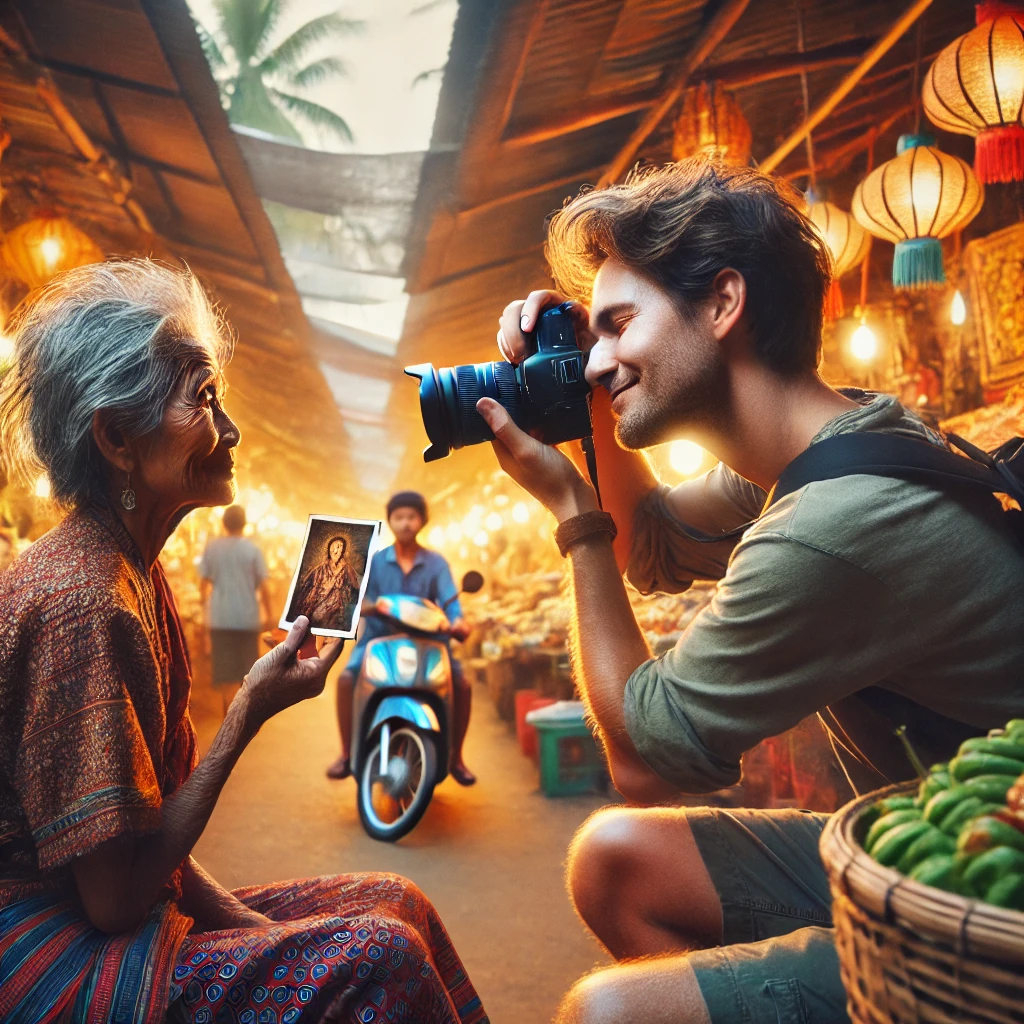Travel photography is an art that goes beyond capturing landscapes and monuments. One of the most powerful elements of travel photography is portraits of strangers—candid moments that tell stories of cultures, traditions, and emotions. However, photographing people in unfamiliar places requires skill, respect, and an understanding of ethical considerations.
In this detailed guide, we’ll explore how to approach strangers, gain their trust, use the right camera settings, and create impactful portraits that stand out in your travel portfolio.
Why Photograph Strangers?
1. Storytelling Through Faces
Portraits of strangers help tell the real stories of the places you visit. Expressions, clothing, and surroundings provide an authentic glimpse into different cultures, showcasing human diversity in a compelling way.
2. Unique & Authentic Moments
Unlike staged travel shots, candid portraits bring out raw emotions and genuine expressions, making them more captivating and relatable.
3. Enhancing Your Travel Portfolio
Photographing people adds depth to your travel portfolio. It differentiates your work by providing a human element to the destinations you cover.
4. Connecting with Cultures
Engaging with people while taking their portraits helps you immerse yourself in local traditions, allowing you to gain a deeper appreciation for the place and its people.
Overcoming Challenges in Portrait Photography While Traveling
1. Shyness & Fear of Rejection
Approaching strangers can be intimidating, but practice builds confidence. Start by smiling, engaging in small talk, and seeking permission politely.
2. Language Barriers
A friendly approach combined with non-verbal cues—like gestures or pointing at your camera—can help communicate your intent. Learning basic local phrases also makes a difference.
3. Cultural Sensitivities
Some cultures have strict rules about photography. Always research local customs beforehand and respect people’s boundaries.
4. Gaining Trust
Building rapport is essential. Instead of snapping a picture immediately, spend time interacting with your subject. A few minutes of conversation can make them comfortable, resulting in natural and expressive portraits.
How to Approach Strangers for Portrait Photography
1. Start with Observational Photography
Before approaching anyone, observe their surroundings. Look for interesting characters, unique expressions, or engaging activities. This will help you identify the perfect subject.
2. Make Eye Contact & Smile
A genuine smile helps break the ice. If the person smiles back, it’s an open invitation to start a conversation.
3. Use a Friendly Introduction
If language permits, introduce yourself and explain why you’d love to take their portrait. Keep it simple:
“Hi! I’m a travel photographer capturing the beauty of this place. Your expression is amazing—would you mind if I took your portrait?”
4. Show Interest in Their Story
People love sharing stories. Ask about their work, culture, or daily life. When they see your genuine interest, they’re more likely to agree to a portrait.
5. Offer to Share Their Portrait
Let them know you’ll send the final photo. Some travelers carry instant print cameras to give a physical copy as a token of appreciation.
6. Respect a “No”
If someone declines, respect their decision and move on gracefully. Avoid being persistent or making them uncomfortable.
Best Camera Settings for Capturing Portraits of Strangers
1. Use a Wide Aperture (f/2.8 – f/5.6)
A wide aperture creates a shallow depth of field, blurring the background while keeping the subject sharp, making the portrait stand out.
2. Adjust Shutter Speed (1/200s – 1/1000s)
Since people move naturally, a fast shutter speed helps freeze their expressions without motion blur.
3. ISO Settings (100-800)
In bright outdoor conditions, use a lower ISO (100-200) to avoid noise. In low-light environments, increase ISO while balancing noise reduction.
4. Focus Mode: Single-Point Autofocus
Use single-point autofocus on the subject’s eyes to ensure a crisp and sharp expression.
5. Natural vs. Artificial Lighting
- Golden hour (early morning or late afternoon) provides soft, flattering light.
- Cloudy weather offers diffused lighting, reducing harsh shadows.
- Reflectors or nearby light sources can help brighten faces.
Composition Techniques for Stunning Portraits of Strangers
1. Rule of Thirds
Position your subject slightly off-center to add dynamism and balance to the frame.
2. Leading Lines
Use natural lines like streets, walls, or fences to guide the viewer’s eye toward the subject.
3. Frame Within a Frame
Utilize doorways, arches, or windows to create a unique framing effect.
4. Environmental Portraits
Incorporate elements of the subject’s environment to tell a deeper story. For example, a fisherman holding a net on the shore conveys his livelihood.
5. Candid vs. Posed Shots
- Candid shots capture spontaneous emotions.
- Posed portraits allow better control over lighting and background.
Post-Processing Tips for Professional-Looking Portraits
1. Basic Adjustments
Enhance exposure, contrast, and white balance to maintain natural skin tones.
2. Retouching
Use healing tools to remove distractions like blemishes while keeping the image realistic.
3. Color Grading
Slight color corrections can enhance mood and improve the visual impact of your portrait.
4. Black & White vs. Color Portraits
Monochrome portraits highlight expressions, while vibrant colors add cultural richness.
Ethical Considerations in Stranger Photography
1. Always Seek Consent
Whenever possible, ask for permission before clicking someone’s portrait.
2. Avoid Misrepresentation
Never alter photos in a way that misrepresents the subject’s story or identity.
3. Respect Privacy
Be mindful when photographing sensitive subjects, especially in religious or vulnerable communities.
4. Do Not Exploit for Gain
If you’re monetizing your travel portraits, ensure that your subjects are aware and compensated when necessary.
Conclusion: Telling Powerful Stories Through Portraits
Capturing portraits of strangers is a rewarding experience that connects you with people and cultures on a profound level. With the right approach, camera techniques, and ethical mindset, you can create compelling travel portraits that tell meaningful stories and leave a lasting impression.
So next time you’re on the road, step out of your comfort zone and try photographing a stranger—you might just capture the best portrait of your journey!

Sony Alpha a7 IV: The Ultimate Camera for Photography

Nikon Z5 Review: Is It Worth It?
-

Nikon Z9 : Game-Changer for Photography
-

Top Features of Nikon D850 That Make It Ideal for Portfolio Shoots
Sony Alpha a7 IV: The Ultimate Camera for Photography
Explore the Sony Alpha a7 IV in this complete 2025 review. Learn how its pro-level features, real-world performance, and hybrid flexibility make it the ultimate camera for photography across genres like portraits, weddings, travel, and commercial work. Table of Contents Section 1: Introduction – Why the Sony Alpha a7 IV Stands Out The Sony Alpha…
Nikon Z5 Review: Is It Worth It?
In 2025, photographers—whether hobbyists, content creators, or professionals—seek equipment that blends value, performance, and future-readiness. Enter the Nikon Z5, a full-frame mirrorless camera marketed as a gateway to high-end imaging without a flagship price tag. But how well does it hold up under real-world demands like studio shoots, weddings, landscape adventures, and lifestyle photography? In…
Nikon Z9 : Game-Changer for Photography
Discover why the Nikon Z9 is considered a true game-changer for photography. This in-depth Nikon Z9 review explores key features, real-world performance, and how it excels in professional photo shoots in 2025. Table of Contents 1. Introduction The photography world witnessed a significant shift with the launch of the Nikon Z9, a flagship mirrorless camera…
Top Features of Nikon D850 That Make It Ideal for Portfolio Shoots
Discover why the Nikon D850 is the ultimate DSLR for portfolio shoots. Explore its top features—from resolution and dynamic range to autofocus precision and workflow speed—that help photographers create stunning, high-impact images for professional portfolios. Whether you’re a portrait artist, fashion photographer, or visual storyteller, a portfolio shoot demands technical excellence, creative flexibility, and uncompromised…
Candid Moments with Canon EOS R10: Lightweight & Reliable
In the evolving world of mirrorless photography, the Canon EOS R10 stands out as a lightweight yet powerful camera tailored for real-life storytelling. Whether you’re photographing street scenes, family gatherings, weddings, or spontaneous portraits, capturing genuine emotion requires a responsive and discreet tool. This article dives deep into how the Canon EOS R10 excels in…
Bold Portraits with Canon EOS R5: Is It the Best for Work?
Studio photography has always demanded precision, artistry, and impeccable gear. As the expectations for commercial portraits, fashion campaigns, and editorial work continue to rise, the tools we use must evolve. Enter the Canon EOS R5, a camera that has stirred the professional waters with its impressive technical specs and forward-thinking design. In this comprehensive Canon…


